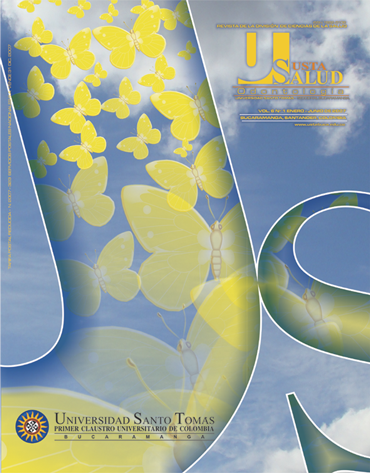INJERTO DE TEJIDO CONECTIVO SUBPEDICULADO Y COLGAJO POSICIONADO LATERAL AVANZADO PARA EL TRATAMIENTO DE UNA RECESIÓN GINGIVAL EN UN PACIENTE CON TRATAMIENTO DE ORTODONCIA: REPORTE DE UN CASO
Resumen
Todo movimiento ortodóntico tiene un efecto directo en el periodonto; se ha reportado la presencia de recesiones gingivales en personas con tratamiento ortodóntico por lo que antes de iniciar un movimiento deben evaluarse adecuadamente los tejidos circundantes. Se presenta el caso de una paciente con retracción del margen gingival a nivel del incisivo central inferior izquierdo y ausencia de encía adherida asociada al tratamiento ortodóntico, se describe la técnica quirúrgica utilizando tejido conectivo subepitelial del paladar combinado con un colgajo desplazado lateral, obteniéndose excelentes resultados estéticos y buena cobertura radicular.
[Díaz AJ, Covo E, Fonseca MA, González KJ, Sagbini A. Injerto de tejido conectivo subpediculado y colgajo posicionado lateral avanzado para el tratamiento de una recesión gingival en un paciente con tratamiento de ortodoncia: Reporte de un caso. Revista Ustasalud Odontología 2007; 6: 53 - 59]
Referencias
2. Marini MG, Greghi SLA, Passanezi E, Santana ACP. Gingival recession: prevalence, extension and severity in adults. J Appl Oral Sci 2004; 12: 250 – 255.
3. Miller PD Jr. A classification of marginal tissue recession. Int J Periodontics Restorative Dent 1985; 5: 8 – 13.
4. Sotres Vasquez J, García López E, Blanco Ruiz A. Retracción gingival e hiperestesia dentinal: Causas y prevención. Rev Cubana Estomatol. [en línea]. 2004; 41: 0-0. URL disponible en http://scielo.sld.cu/scielo.php?script=sci_arttext&pid=S0034-75072004000200008&Ing=es&nrm=iso
5. Smith R. Gingival recessión. J Clin Periodontol 1997; 24: 201 - 205.
6. Allen E, Miller, P. Coronal positioning of existing gingiva: short term results in the treatment of shallow marginal tissue recession. J Periodontol 1989; 60: 316 - 319.
7. Ericsson I, Lindhe J. Recession in sites with inadequate width of the keratinized gingiva. An experimental study in the dog. J Clin Periodontol 1984; 11: 95 - 103.
8. Van Palenstein Helderman WH, Lembariti BS, van der Weijden GA, van’t Hof MA. Gingival recession and its association with calculus in subjects deprived of prophylactic dental care. J Clin Periodontol 1998; 25: 106 – 111.
9. Coatoam GW and others. The width of keratinized during orthodontic treatment: its significance and impact on periodontal status. J Periodontol 1981; 52: 307 – 313.
10. Andlin-Sobocki, Bodin L. Dimensional alterations of the gingival related to changes of facial/lingual tooth position in permanent anterior teeth of children. A 2-year longitudinal study. J Clin Periodontol 1993; 219 – 224.
11. Díaz A, Florez JE, Reyes K, Sáenz A, Sepúlveda D, Vargas G, González F. Prevalencia de recesiones gingivales en pacientes con tratamiento ortodóntico atendidos en la clínica del Postgrado de Ortodoncia de la Universidad de Cartagena entre el 2004 – 2005. XVII Encuentro Nacional de Investigación Odontológica ACFO - I Reunión de la International Association for Dental Research (Memorias) Bucaramanga, Colombia 2006. p. 48.
12. Bernimoulin JP, Luscher B, Muhlemann HR. Coronally repositioned periodontal flap. Clinical evaluation after 1 year. J Clin Periodontol 1975; 2: 1 -13.
13. Guinard EA, Caffesse RG. Treatment of localized gingival recessions. Part I. Lateral sliding flap. J Periodontol 1978; 49: 351 - 356.
14. Raetzke PB. Covering localized areas of root exposure employing the «envelope» technique. J Periodontol 1985; 56: 397 - 402.
15. Langer S, Langer L. Subepithelial connective tissue graft technique for root coverage. J Periodontol 1985; 56:715-720.
16. Tozum TF. A promising periodontal procedure for the treatment of adjacent gingival recession defects. J Can Dent Assoc 2003; 69: 155 – 159.
17. Goldstein M, Brayer L, Schwartz Z. A critical evaluation of methods for root coverage. Crit Rev Oral Biol Med 1996; 7: 87 – 98.
18. Wennstrom JL, Zucchelli G. Increased gingival dimensions. A significant factor for successful outcome of root coverage procedures? A 2-year prospective clinical study. J Clin Periodontol 1996; 23: 770 - 777.
19. Grupe J, Warren R. Repair of gingival defects by a sliding flap operation. J Periodontol 1956; 27: 290 -295.
20. Nelson S. The subpedicle connective tissue graft: A bilaminar reconstructive procedure for the coverage of denuded root surfaces. J Periodontol 1987; 58: 95 - 102.
21. Harris RJ. The connective tissue and partial thickness double pedicle graft: A predictable method of obtaining root coverage. J Periodontol 1992; 63: 477 - 486.
22. Saygun I, Karacay S, Ózdemir A, Sagdiç. Multidisciplinary treatment approach for the localized gingival recession: A case report. Turkish J of Med Sci 2005; 35: 57 - 63.
23. Pearson L. Gingival height of lower central incisors orthodontically treated and untreated. Angle Orthod 1968; 38: 337 - 339.
24. Maynard JG, Ochsenben D. Mucogingival problems, prevalence and therapy in children. J Periodontol 1975; 45: 543 - 552.
25. Foushee DG, Moriarty JD, Simpson DM. Effects of mandibular orthognathic treatment on mucogingival tissues. J Periodontol 1985; 56: 727 – 733.
26. Dorfman H. Mucogingival changes resulting from mandibular tooth movement. Am J Orthod 1978; 74: 286 – 297.
27. Allen AL. Use of the supraperiosteal envelope in soft tissue grafting for root coverage I. Rationale and technique. Int J Periodontics Restorative Dent 1994; 14: 216 - 227.
28. Jahnke PV, Sandifer JB, Gher ME, Gray JL, Richardson AC. Thick free gingival and connective tissue autografts for root coverage. J Periodontol 1993; 64: 315 - 322.
29. Paolantonio M, di Murro C, Cattabríga A, Cattabriga M. Subpedicle connective tissue graft versus free gingival graft in the coverage of exposed root surfaces. A 5-year clínical study. J Clin Periodontol 1997; 24: 51 - 56.
30. De Sanctis M, Zucchelli G. Coronally advanced flap: a modified surgical approach for isolated recession-type defects: three-year results.J Clin Periodontol. 2007; 34: 262 – 268.
31. Cavalho PF, da Silva RC, Cury PR, Joly JC. Modified coronally advanced flap associated with a subepithelial connective tissue graft for the treatment of adjacent multiple gingival recessions. J Periodontol 2006; 77: 1901- 1906.















